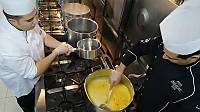
Art of Neapolitan ‘Pizzaiuolo’
Inscribed,Art of Neapolitan ‘Pizzaiuolo’ The art of the Neapolitan ‘Pizzaiuolo’ is a culinary practice comprising four different phases relating to the preparation of the dough and its baking in a wood-fired oven, involving a rotatory movement by the baker. The element originates in Naples, the capital of the Campania Region, where about 3,... Italy
The Committee Takes note that Tunisia has nominated Harissa, knowledge, skills and culinary and social practices (No. 01710) for inscription on the Representative List of the Intangible Cultural Heritage of Humanity: Harissa, a seasoning made with chilli pepper paste, is an integral part of domestic provisions and the daily culinary and food trad...3 December 2022
Rabat
has been passed down from generation to generation to ensure the sustainability of local traditional culinary practices. Locals from different ethnic groups and genders unite around traditional breakfast delicacies. In addition to being a source of pride and a significant part of Malaysia’s gastronomic history, these morning dishes have also bec...6 December 2024
Asunción
Al-Man’ouché, an emblematic culinary practice in Lebanon
inscribed,Al-Man’ouché, an emblematic culinary practice in Lebanon The quintessential Lebanese breakfast, Al-Man’ouché is a flatbread prepared in homes and specialized bakeries, and enjoyed by people of all backgrounds. The dough is indented using the fingertips and topped with a mixture of thyme, sumac, toasted sesame seeds, salt and olive o... Lebanon
Traditional knowledge and practices for the making and consumption of cassava bread
nsmitted informally, within households and communities. They are also transmitted through media and culinary institutes. In most countries, cassava bread is a key part of daily diets and provides a connection with the communities’ Indigenous and African heritage. It promotes tolerance and unity, as each community values its own cassava bread maki... Cuba
, Haiti
, Honduras
oking methods including scalding, steaming, boiling, roasting, blending, pickling and fermenting. The culinary tradition nearly became extinct with the end of the Joseon dynasty in 1910, but was revitalized by the private sector in the 1940s and 1950s, and is enjoyed by the general public today. Two designated masters and two specialized institutes...29 November 2011
Bali
and the ecosystem. There are also numerous social practices resulting from the practice as well as culinary and traditional medicine traditions. As in the past, the transmission of the element takes place mainly in tree beekeepers’ families and through the act of brotherhoods. Nowadays, however, workshops offer another mode of transmission durin... Belarus
, Poland
Community-based inventorying to safeguard the intangible cultural heritage in western Guatemala
participatory observations of local ICH elements and record them, such as the ´Torito´s dance´, local culinary traditions, weaving techniques and ceramic production.,Community-based inventorying to safeguard the intangible cultural heritage in western Guatemala,Santa Apolonia, Guatemala,...5 June 2017 - 9 June 2017
Santa Apolonia, Guatemala
Al-Mansaf in Jordan, a festive banquet and its social and cultural meanings
ecipes and related practices (such as milking the goat or sheep) to their daughters and granddaughters. Culinary institutes and universities also contribute to the dish’s transmission.... Jordan
Nar Bayrami, traditional pomegranate festivity and culture
, traditions and skills related to the cultivation of the fruit, which is used not only in a range of culinary contexts, but is also referred to in crafts, decorative arts, myths, storytelling and other creative outlets. The element is linked to local agriculture and to the farmers and individuals in rural communities that grow and collect the frui... Azerbaijan










